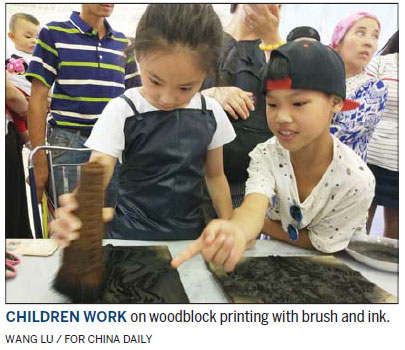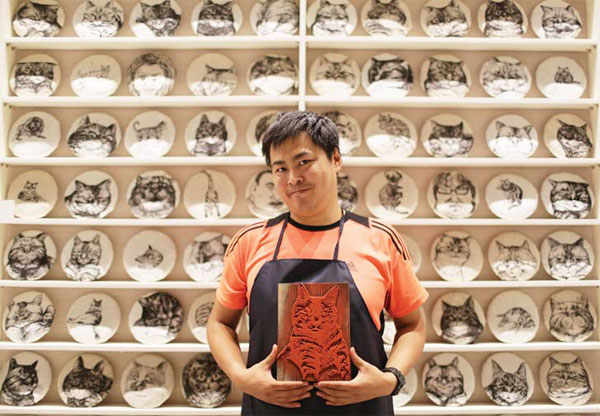In fight to save the old, machines become an ally

Unlike many woodblock carvers, who promote engraved block printing by teaching it to others, Wang Lu thinks the best way to raise awareness of the craft and ensure its survival is to give the uninitiated some hands-on experience.
Recently, he organized an event in the Beijing Ancient Coin Museum in which he presented woodblocks engraved with the pattern of banknotes used in the Ming (1368-1644) and Qing (1644-1911) dynasties, and made ink and brushes available to visitors so they could get a feel of what printing the old money was like.
"People were excited about becoming 'rich' with the 'money' they printed," Wang says. Parents of about 15 children took them to take part in the event.

"On Aug 13, we held a similar event in Beijing's National Library, and this time members of the public had the chance to print on old Chinese letter paper."
Each program includes a 20-minute introduction to the history of woodblock printing, he says.
Wang is the founder of Oude Woodblock Printing Workshop. Unlike in traditional workshops, which are highly labor-intensive, he uses machines to carve woodblocks, and has organized more than 50 hands-on experience programs since last year.
The 40-year-old, who was born in Shenyang, Liaoning province, says he had several occupations, including as a 3-D animation designer, English teacher and ancient bookseller, before he plumped for the printing business.
The workshop, founded in 2012, initially focused on making woodblocks to reprint ancient and rare books and selling them to collectors. Wang soon found that if he commissioned artisans to make woodblocks it would take months if not years to produce just one book, so he had his own carving machine made specially for woodblock engraving.
In the first nine months, he tested different wood pieces and carving machines and modified them to reach what he reckoned was the same quality as handmade woodblocks.
However, sluggish sales suggested that collectors were not particularly enamored of woodblocks turned out by machine; they were eager to obtain handmade versions.
During the Beijing International Cultural and Creative Industry Expo in September last year, Wang found a new niche market. To save on the expo registration fee, he contacted a collective of four museums, saying he could put on engraved woodblock printing demonstrations for them if they allowed him to put his works on show in their institutions.
The offer was accepted, and to his surprise the woodblocks began to attract large crowds. Many people came to see and feel for themselves how printing was done hundreds of years ago, and museum curators saw it as a good interactive program to run alongside their regular displays.
Since then, the popularity of Wang's workshops has steadily grown. In the past year alone, he has worked with about 20 museums, big and small, and other cultural organizations, providing hands-on woodblock demonstrations.
"Our machines can make woodblocks much more quickly than craftsmen, and you don't have to limit what is on the blocks to just Chinese characters; you can show whatever you like. I think we have broadened the scope of woodblock printing."
In addition to organizing demonstrations, Wang makes coloring books with traditional Chinese Spring Festival designs printed by engraved woodblocks, a nod to the recent fad for coloring books for grown-ups.
Recently, he has started contacting illustrators and painters, trying to reproduce their works with woodblock printing.
He says he is a bit of an outsider in the traditional woodblock printing world. Although he respects woodblock craftsmen, he thinks that in order to save the craft, ways need to be found to appeal to what people are interested in these days.
"If you compare saving woodblock printing to saving the panda, what I do is a bit like artificial breeding. Yes, natural breeding is great, but it's not enough to prevent extinction."
xingyi@chinadaily.com.cn
| Wang Lu, founder of the Oude woodblock printing workshop. Sang Xiaojie / For China Daily |
(China Daily Africa Weekly 09/02/2016 page16)
Today's Top News
- US plan for arms sales to Taiwan condemned
- China creates 12.1m new urban jobs
- Dialogue constructive way to rebalance trade
- AI needs to be governed wisely to ensure that it is beneficial for future of humanity: China Daily editorial
- China warns about Japan's intended military buildup
- China urges EU to halt anti-subsidy probes































